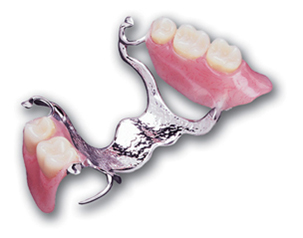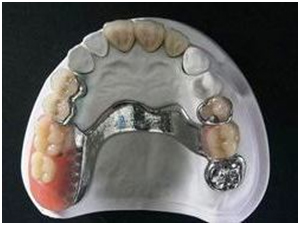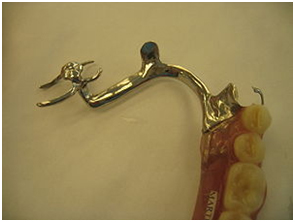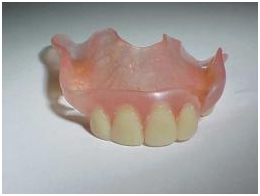
If you are missing only a few teeth scattered over either arch (upper or lower teeth), or even if you have a minimum of two teeth on both sides of the arch, then you can most inexpensively replace the missing teeth with a Removable Partial Denture (RPD). There are several types of RPD's. All of them use standard plastic denture teeth as replacements for the missing natural teeth. The differences between them are the materials that are used to support the denture teeth and retain the RPD in the mouth.
Cast Partial Denture (CPD's)



The flexible framework RPD's

The most recent advancement in dental materials has been the application of nylon-like materials to the fabrication of dental appliances. Nylon generally replaces the metal, and the pink acrylic denture material used to build the framework for standard removable partial dentures. Nylon is similar to the material used to build those fluorescent orange traffic cones you sometimes see on highways. It is nearly unbreakable, is colored pink like the gums, can be built quite thin, and can form not only the denture base, but the clasps as well. Since the clasps are built to curl around the necks of the teeth, they are practically indistinguishable from the gums that normally surround the teeth. Brands of this type are: Luciton FRS, Duraflex or Valplast
Even though this type of denture does not rest on the natural teeth like the metal framework variety, the clasps rest on the gums surrounding the natural teeth. This tissue, unlike the gums over extraction sites, is stable and changes very little over time which keeps these RPD's stable and unchanging similar to the cast metal variety. The clasps can be seen on the image. This type of partial denture is extremely stable and retentive, and the elasticity of the flexible plastic clasps keeps them that way indefinitely.
The Treatment RPD (flippers)

Affectionately known in dentistry as a "flipper", this is the least expensive of all the removable partial dentures. The one pictured on the right replaces 4 missing teeth, leaving spaces for 7 natural teeth. Two of the natural teeth are clasped with wrought wire clasps which are cured into the structure of the denture base.
The pink plastic of the denture base is brittle acrylic, the same material used to make standard full dentures. The largest single advantage to this type of RPD (aside from the cost) is that new teeth and new denture base can easily be added to an existing treatment RPD. These are frequently fabricated even if the remaining teeth have existing
decay or periodontal disease and their prognosis is doubtful. If later in the course of treatment some of the existing natural teeth are extracted for any reason, new false teeth can be added quickly to the partial, maintaining the patient's appearance. In spite of the fact that they are considered a temporary solution, many people keep this type of appliance for many, many years, because as long as they are properly maintained, they look outwardly as good as the more expensive permanent appliances described below.
In due course of time these flippers are highly damaging to the underlying gums, bone & teeth. Since they take support from those teeth which are already week due to pyorrhea. So, the remaining teeth may also be lost due to the design of flippers.
In Conclusion, for a good Removable Partial Denture there is nothing better than a Cast metal Framework with Acrylic teeth & connecting material as pink color acrylic (plastic) ideally called as Cast Partial Denture. In which Precision of metal alloys takes support from the teeth without damaging them, crosslinked Acrylic teeth are also not damaging to the opposing teeth & pink color acrylic mimics the natural color of the gums.
You are going to get the best for yourself as you reach Dr. Grover's Dental Clinic Multispeciality Dental Care Centre. Your situation of all the remaining teeth is assessed first with Diagnostic impressions & study models are made for all the cases. Designing for your future Prosthesis is done by Dr. Somesh Grover specialist Prosthodontist & Geriatric Dentist.




